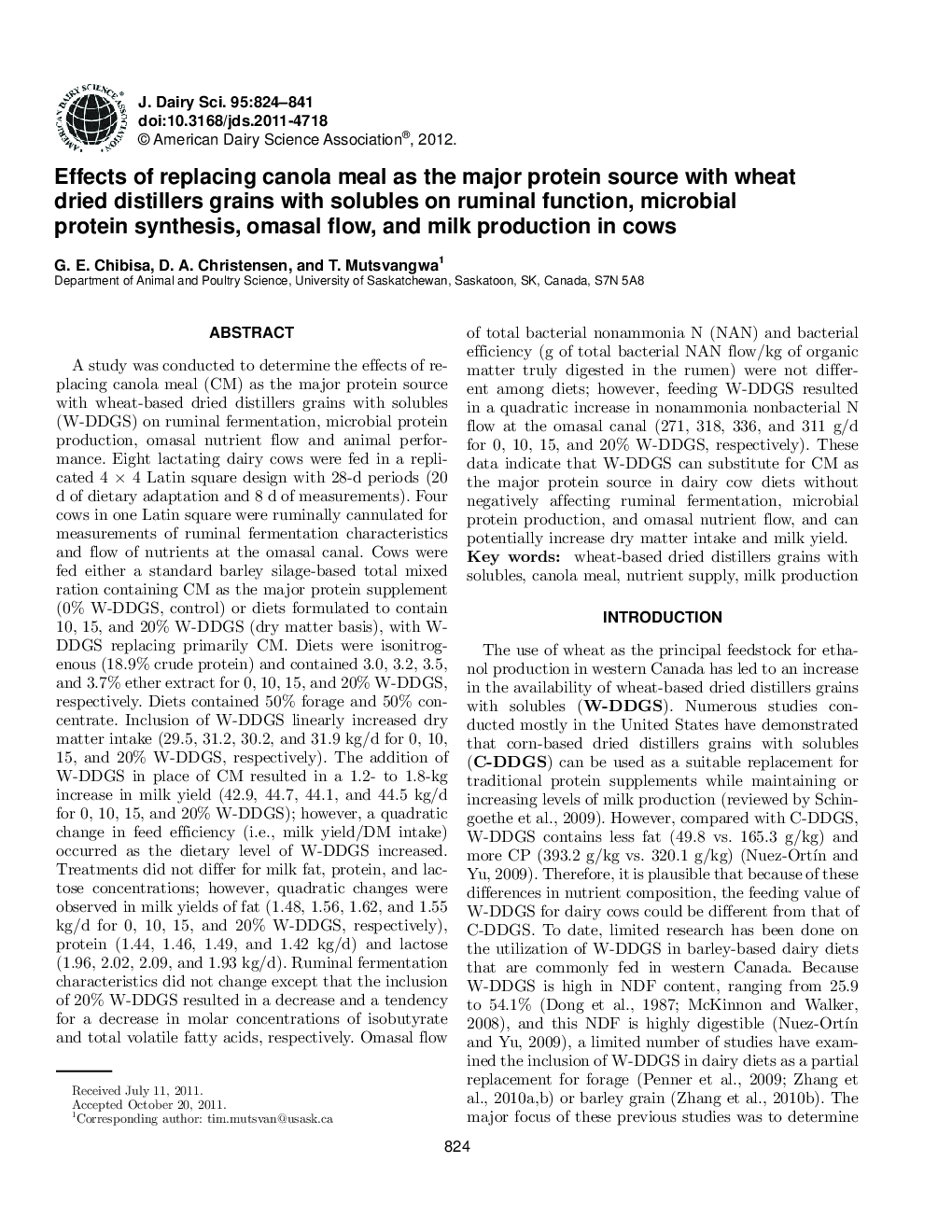| کد مقاله | کد نشریه | سال انتشار | مقاله انگلیسی | نسخه تمام متن |
|---|---|---|---|---|
| 10977466 | 1108049 | 2012 | 18 صفحه PDF | دانلود رایگان |
عنوان انگلیسی مقاله ISI
Effects of replacing canola meal as the major protein source with wheat dried distillers grains with solubles on ruminal function, microbial protein synthesis, omasal flow, and milk production in cows
دانلود مقاله + سفارش ترجمه
دانلود مقاله ISI انگلیسی
رایگان برای ایرانیان
موضوعات مرتبط
علوم زیستی و بیوفناوری
علوم کشاورزی و بیولوژیک
علوم دامی و جانورشناسی
پیش نمایش صفحه اول مقاله

چکیده انگلیسی
A study was conducted to determine the effects of replacing canola meal (CM) as the major protein source with wheat-based dried distillers grains with solubles (W-DDGS) on ruminal fermentation, microbial protein production, omasal nutrient flow and animal performance. Eight lactating dairy cows were fed in a replicated 4 Ã 4 Latin square design with 28-d periods (20 d of dietary adaptation and 8 d of measurements). Four cows in one Latin square were ruminally cannulated for measurements of ruminal fermentation characteristics and flow of nutrients at the omasal canal. Cows were fed either a standard barley silage-based total mixed ration containing CM as the major protein supplement (0% W-DDGS, control) or diets formulated to contain 10, 15, and 20% W-DDGS (dry matter basis), with W-DDGS replacing primarily CM. Diets were isonitrogenous (18.9% crude protein) and contained 3.0, 3.2, 3.5, and 3.7% ether extract for 0, 10, 15, and 20% W-DDGS, respectively. Diets contained 50% forage and 50% concentrate. Inclusion of W-DDGS linearly increased dry matter intake (29.5, 31.2, 30.2, and 31.9Â kg/d for 0, 10, 15, and 20% W-DDGS, respectively). The addition of W-DDGS in place of CM resulted in a 1.2- to 1.8-kg increase in milk yield (42.9, 44.7, 44.1, and 44.5Â kg/d for 0, 10, 15, and 20% W-DDGS); however, a quadratic change in feed efficiency (i.e., milk yield/DM intake) occurred as the dietary level of W-DDGS increased. Treatments did not differ for milk fat, protein, and lactose concentrations; however, quadratic changes were observed in milk yields of fat (1.48, 1.56, 1.62, and 1.55Â kg/d for 0, 10, 15, and 20% W-DDGS, respectively), protein (1.44, 1.46, 1.49, and 1.42Â kg/d) and lactose (1.96, 2.02, 2.09, and 1.93Â kg/d). Ruminal fermentation characteristics did not change except that the inclusion of 20% W-DDGS resulted in a decrease and a tendency for a decrease in molar concentrations of isobutyrate and total volatile fatty acids, respectively. Omasal flow of total bacterial nonammonia N (NAN) and bacterial efficiency (g of total bacterial NAN flow/kg of organic matter truly digested in the rumen) were not different among diets; however, feeding W-DDGS resulted in a quadratic increase in nonammonia nonbacterial N flow at the omasal canal (271, 318, 336, and 311Â g/d for 0, 10, 15, and 20% W-DDGS, respectively). These data indicate that W-DDGS can substitute for CM as the major protein source in dairy cow diets without negatively affecting ruminal fermentation, microbial protein production, and omasal nutrient flow, and can potentially increase dry matter intake and milk yield.
ناشر
Database: Elsevier - ScienceDirect (ساینس دایرکت)
Journal: Journal of Dairy Science - Volume 95, Issue 2, February 2012, Pages 824-841
Journal: Journal of Dairy Science - Volume 95, Issue 2, February 2012, Pages 824-841
نویسندگان
G.E. Chibisa, D.A. Christensen, T. Mutsvangwa,